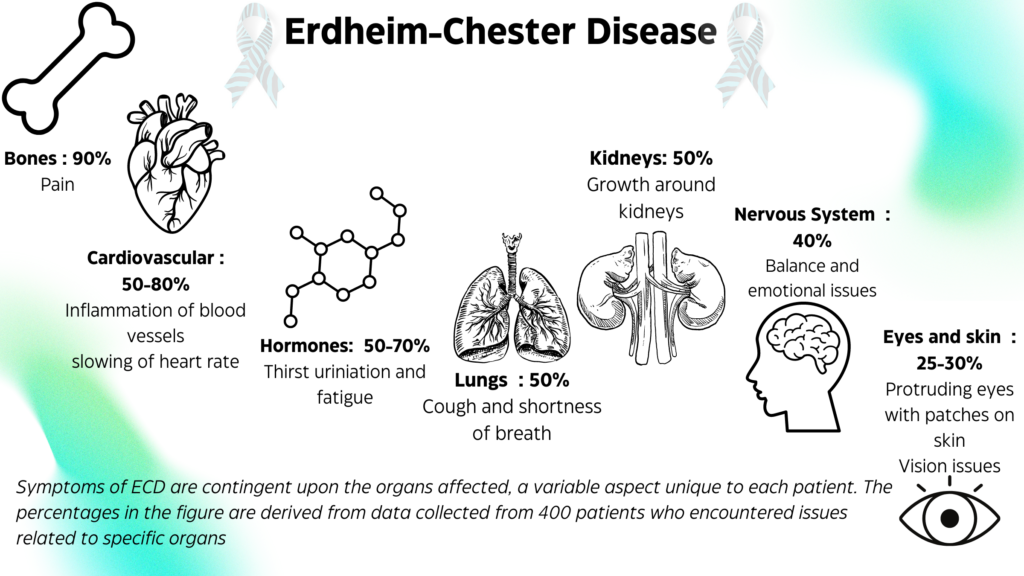Erdheim-Chester Disease (ECD) is an extremely rare multisystem adult-onset histiocytic disorder which is a type of a slow-growing blood cancer. Histiocytes are large phagocytic cells, typically tasked with combatting infections. In this disease, there is an excessive accumulation of histiocytes which infiltrate the body’s loose connective tissue, triggering inflammation and thickening of the affected areas. Left untreated, this process can lead to organ failure. ECD severity can vary, ranging from a mild form impacting only a few organs to a more aggressive manifestation affecting multiple organs such as bones, skin, heart, and brain (see figure). Previously considered to be an autoimmune disorder this was recategorized as blood cancer specifically histiocytic neoplasm in 2016 by WHO due to the discovery of mutations of genes in MAP kinase pathway namely BRAF, KRAS, MAP2K1, NRAS. September is Histiocytosis Awareness Month.
| Classification Level | Disorder |
| Worldwide Prevalence | Unknown |
| Age of Onset | Adulthood, ~ 50 years |
| Inheritance | NA |
Clinical Description
- Noted in ages 40-60 with a 3:1 male to female ratio and clinical course varies from asymptomatic to multisystemic, life-threatening forms.
- Symptoms vary with organ affected and disease severity; fatigue, weight loss, night sweats, low grade fevers, muscle and joint aches are common symptoms irrespective of organ involvement.
- ECD typically affects long bones around the knees and related symptoms can be bilateral bone pain in the legs or knees.
- Abdominal or lower back pain, painful urination, or severe kidney impaction from growth around kidney, approximately 30% of patients experience diabetes insipidus.
- Effects on the nervous system may include coordination difficulties, balance issues, falls, slurred speech, behavior changes, and muscle weakness along with mood swings, uncontrollable crying, anxiety, depression, and memory problems, even with a normal brain MRI.
- Cardiac symptoms often are manifested as shortness of breath, fatigue, and swelling in the lower extremities whereas pulmonary symptoms are dry cough, sinus congestion due to pleural involvement.
- Lastly, pressure in the eye socket, resulting in pain, redness, bulging eyes, or visual disturbances and yellowish-orange patches around the eyes (xanthelasmas) or skin bumps.
- Poor prognosis in those with CNS involvement. Current mortality rate is only 26%, and 5-year survival is 68%.

Figure: Erdheim-Chester Disease(ECD), Image source: Malini Gupta
Diagnosis and Current Treatment
Diagnosing ECD involves a combination of imaging tests, histological examination of biopsy samples, molecular testing for genetic mutations, and laboratory evaluations to assess organ function and hormonal levels. Differential diagnosis is crucial to differentiate ECD from other similar conditions. PET CT scan from head to toes is preferred as it provides comprehensive assessment for disease presence, looking for abnormalities in bones around the knee, including bilateral and symmetric cortical osteosclerosis, and abnormal labeling of the distal ends of long bones, especially in lower limbs. Tissue biopsies often look for characteristic foamy histiocytes with signs of inflammation and staining positive for CD68 and factor XIIIa, and negative staining for CD1a. Next generation sequencing (NGS) can aid in diagnosis of associated gene mutations in addition to complete blood count with differential, and other routine metabolic panels.
The choice of treatment is tailored to the patient’s clinical presentation and disease characteristics, and this may range from immunotherapy using interferon alpha administration, MEK inhibitors, IL-1 antagonists, mTOR inhibitors, Tyrosine Kinase inhibitors. The treatment regime focusses on improving symptoms, controlling disease progression, and optimizing quality of life. Patients without symptoms may undergo a period of observation without immediate treatment.
For more on the latest curatives for this disease, stay tuned for E for Erdheim Chester Disease part II. Meanwhile, click on the link below for more available resources and support groups for Erdheim Chester Disease.
Dr. Malini Gupta, Ph.D.
Sources



